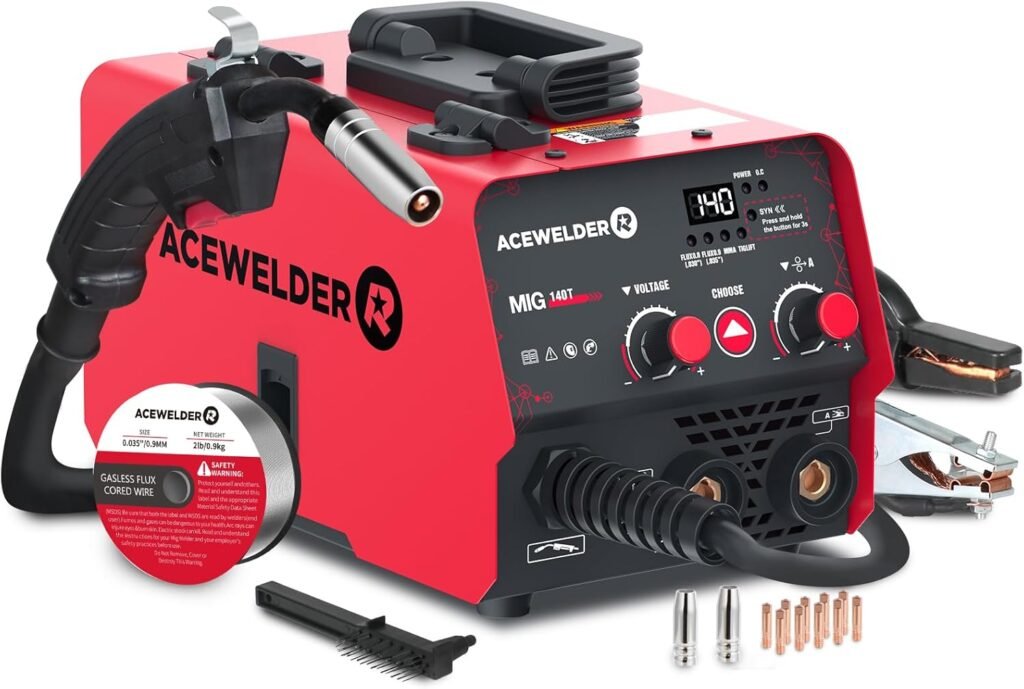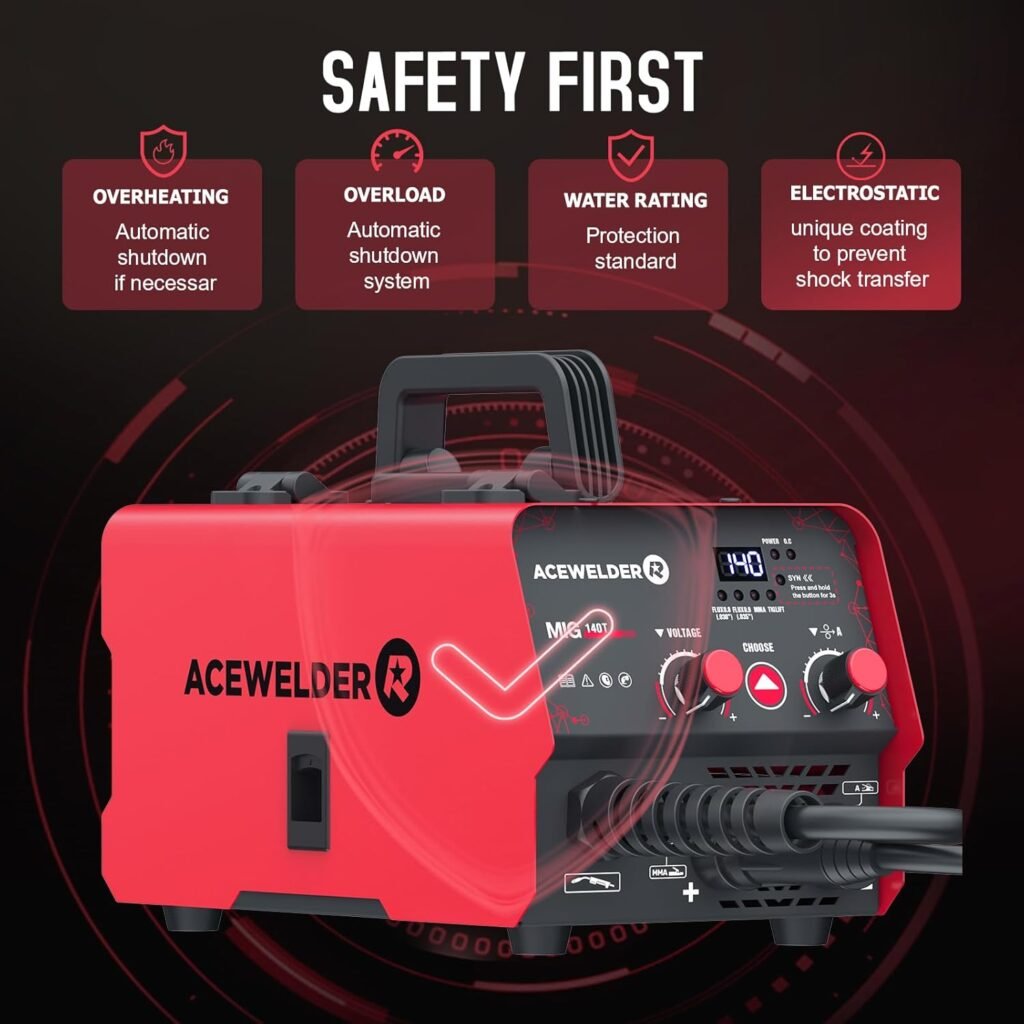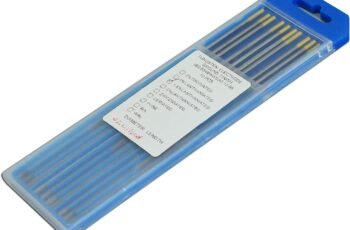Ad Blocker Detected
Our website is made possible by displaying online advertisements to our visitors. Please consider supporting us by disabling your ad blocker.
Looking for a compact all-in-one welder that can handle home projects, repairs, and light professional work?
Quick Verdict
You get a versatile 3-in-1 machine that covers flux-core MIG, MMA (stick), and Lift TIG modes, which is handy if you want one tool to cover many jobs. For its size and price category, the ACEWELDER MIG140T offers surprising capability, portability, and thoughtful safety features that make it a strong option for DIYers and hobbyists.
What the ACEWELDER MIG140T Is
This is a 140A gas-free flux core MIG welder marketed as a 3-in-1 inverter machine that also supports MMA and Lift TIG modes. It’s designed for users who need a lightweight, portable unit that can handle thin sheet metal, repairs around the home, and occasional shop tasks without the complexity or cost of larger industrial welders.
Key Features Overview
You’ll appreciate the synergy function that automatically matches voltage and wire feed speed when you select the wire diameter, which simplifies setup for beginners. The unit also offers a manual MIG mode for users who prefer to fine-tune voltage and wire speed themselves, plus thermal overload protection and an inverter-based IGBT design for consistent arc performance.
What You Get in the Box
When you open the package, the machine is ready to run on the common consumables included—so you can start practicing or repairing right away. The accessory pack is fairly complete for basic MIG and stick work, but additional items will be useful if you plan to use Lift TIG or pursue more advanced TIG jobs.
| Included Item | Purpose / Notes |
|---|---|
| 140 MIG Welder (Main Unit) | IGBT inverter-based power source, main controls and connectors |
| MIG Torch | For flux-core MIG welding; compatible with included contact tips/nozzles |
| Electrode Holder | For MMA (stick) welding |
| Ground Clamp | Standard workpiece grounding clamp and cable |
| Brush | For cleaning welds and prepping surfaces |
| 0.8 mm Flux Core Wire (small roll) | Ready-to-use wire for gasless MIG welding |
| 10 x Contact Tips, 2 x Nozzles | Consumables for the MIG torch, spare tips included |
Technical Specifications at a Glance
You’ll find the key numbers that affect daily use collected here so you can quickly compare with other welders or decide if this unit meets your needs. Keep in mind that actual welding performance depends on settings, technique, and the specific materials you work with.
| Specification | Value / Notes |
|---|---|
| Rated Output | 140 A (max) |
| Input Voltage | 110 V (single phase) |
| Welding Modes | Flux Core MIG / MMA (Stick) / Lift TIG |
| Wire Sizes Supported | Compatible with common flux-core ranges; includes 0.8 mm roll |
| Maximum Soft Plate Thickness | Up to ~4 mm (recommended for decent bead penetration) |
| Weight | ~9 lbs (lightweight, portable) |
| Safety Features | Overheat and over-current protection, IGBT inverter control |
| Included Roll Size Capacity | Fits up to 1 kg wire rolls |
Performance and Welding Capabilities
The ACEWELDER MIG140T is designed to handle light-to-medium tasks: thin sheet metal, rust repairs, hobby work, and small structural or farm fixes. You should expect good results on mild steel up to roughly 4 mm when set and executed properly, while thicker plate work will require multiple passes or a more powerful machine.
MIG (Flux Core) Mode Performance
In flux-core MIG mode you get gasless welding, which makes outdoor and windy conditions much more manageable compared with gas-shielded MIG. The synergy mode automatically sets a balanced combination of voltage and wire feed speed once you pick the wire diameter, which reduces the fiddling required to chase a stable arc and improves first-time success rates for novices.
MMA (Stick) Mode Performance
MMA or stick mode is useful when you need portability and don’t want to rely on spool wire setups—especially for repairs in remote places or farms. You can use standard stick electrodes for thicker, rustier metal and in less-than-ideal surface conditions, and the included electrode holder gets you started right away.
LIFT TIG Mode Performance
Lift TIG mode is a welcome addition for light TIG tasks and finishing work, but it comes with caveats: TIG welding normally requires a TIG torch, tungsten electrode, and shielding gas (argon) for proper results, and these items are not included in the basic package. If you want to use TIG regularly, plan to add a TIG torch kit and a gas cylinder, and practice the arc initiation and foot/pulse control techniques required for clean TIG welds.
Metal Thickness and Material Compatibility
You’ll find the sweet spot for this machine is thin to medium-thickness mild steel, sheet metal, and common alloys used in automotive and home repair. The machine’s 140A rating and advertised ability to weld a soft plate up to 4 mm make it ideal for bodywork, hobby fabrication, and light structural tasks; heavier plate and thicker sections require more power and a different workflow.
Usability and Controls
The control panel is straightforward and optimized for beginners and casual users while still offering manual adjustments for more experienced welders. You’ll have access to voltage and wire speed settings for manual MIG, a switch for synergic mode, and easy toggles for selecting between MIG, MMA, and Lift TIG.
Synergistic MIG vs Manual MIG
The synergy mode is particularly helpful if you don’t want to spend hours adjusting settings: choose your wire diameter and the machine will pair an appropriate voltage and wire feed speed automatically. If you’re an experienced welder and prefer hands-on control, manual MIG mode lets you fine-tune voltage and wire feed to suit your specific technique and material.
Setup and Wire Loading
Wire loading is designed to be simple: the drive mechanism fits common spool sizes up to 1 kg, and the included 0.8 mm spool gets you started. Make sure you thread the liner and contact tip correctly, set the polarity as recommended for flux core, and check the tension on the drive roller to avoid bird-nesting or feeding issues.
Controls Layout and Readability
You’ll find a clear interface with knobs and switches that are easy to operate even with gloves on, and the compact footprint means you can place the unit near your workspace without it getting in the way. Labels and indicator lights help you confirm the mode and whether the machine has entered thermal protection.
Portability and Build
At around 9 pounds, this welder is easy to carry from the garage to the yard or a remote job site, and the built-in handle feels comfortable for short transports. The metal and plastic housing gives it a balanced feel between portability and durability, though it’s not designed to resist heavy industrial abuse—treat it like a well-built tool for light-to-medium use.
Ideal Transport and Storage Practices
You should protect the unit from moisture and road vibration when transporting it in a truck or trailer—secure it in a case or under a tarp if you’re moving it frequently. Store it in a dry, dust-free place and wrap or separate the torch and cables to avoid wear on consumable leads.
Safety Features
Safety matters with any power tool. This unit includes overheat protection, overcurrent protection, and the inherent benefits of an inverter (more stable arc, fewer spikes), so you’ll experience a level of protection that’s reassuring for beginners and occasional users.
Duty Cycle and Thermal Protection
Expect a limited duty cycle at maximum output—like many compact inverters, the 140A rating is a short-burst capability rather than continuous duty for heavy industrial tasks. The internal thermal protection will automatically shut the unit down if temperatures rise too high; you’ll need to allow cool-down periods during extended welding sessions to preserve the machine.
Accessories and Consumables
The included items give you a quick start for basic flux-core MIG and stick welding tasks, and the spare tips and nozzles help you keep working while you order replacements. However, consumables like contact tips, nozzles, and wire will wear with use, so you’ll want spares on hand if you plan frequent welding.
Accessories Included (Breakdown Table)
You’ll appreciate that the essentials are covered in the box; here’s a quick breakdown of what you receive and what each piece allows you to do.
| Accessory | Why It Matters |
|---|---|
| MIG Torch | Performs flux-core MIG welding; compatible with included tips/nozzles |
| Electrode Holder | Enables MMA/stick welding on-site without extra purchases |
| Ground Clamp | Essential for safe, effective welding circuit completion |
| Wire Roll (0.8 mm) | Start welding immediately with a commonly used wire size |
| Contact Tips & Nozzles | Consumables that wear; spares are useful for uninterrupted work |
| Brush | Useful for cleaning slag and prepping metal for better welds |
What Else You Might Want to Buy
You’ll probably want a good auto-darkening helmet, welding gloves, and safety gear before you start; those are non-negotiables for comfort and protection. If you intend to use the Lift TIG mode seriously, plan to add a TIG torch (if not provided in your model’s pack), a gas cylinder (argon), a regulator, and tungsten electrodes—TIG requires additional investment and skill compared to flux-core MIG.
Pros and Cons
You’ll get an honest look at what this machine does well and its limitations so you can make an informed purchase decision based on the projects you plan.
Pros:
- Lightweight and highly portable—easy to carry to different job sites.
- 3-in-1 capability gives flexibility for multiple welding methods in one box.
- Synergy mode simplifies MIG setup for beginners.
- Includes a practical set of consumables to get you started.
- Built-in safety systems protect the unit and reduce risk of damage.
Cons:
- Limited duty cycle at maximum output—unsuited for heavy, extended production welding.
- Lift TIG functionality requires additional gear (torch, gas) not included.
- Best for thin to medium sheet metal—struggling with very thick plate without multiple passes.
- Some specs in marketing copy may be unclear (wire diameter listings vary), so check compatibility carefully.
Real-World Use Cases
You’ll want to match the machine to jobs it can do well—this unit fits many practical scenarios without overpromising industrial capability. Think of it as a versatile companion for light fabrication, repairs, and hobbyist work rather than a full production solution.
Home and Hobby Projects
For furniture repair, metal art, lawn equipment maintenance, and general garage tinkering, this machine gives you the tools to complete attractive, functional welds. The gas-free flux-core mode makes it convenient for patching metal in your driveway or workspace without managing gas bottles.
Light Farm and Repair Work
You can carry the unit around the farm for fence repairs, trailer patching, or quick bracket fixes where portability and simplicity matter. Use stick mode when you’re working on dirty or painted metal outdoors, and use MIG for faster bead laying on cleaned surfaces.
Automotive and Bodywork
If you’re repairing sheet metal on cars, motorcycles, or small trailers, the machine’s 4 mm capability and flux-core wire can produce acceptable results for many bodywork tasks. Keep in mind that if you need clean, precise TIG welds for delicate panels, you’ll need to invest in TIG accessories and gas.
Tips for Best Results
You’ll get better welds faster if you follow a few practical tips focused on setup, material prep, and technique. Proper preparation and sensible settings make a bigger difference than raw amperage.
- Clean the metal: remove rust, paint, and oil where possible for more consistent penetration and less spatter.
- Match wire diameter to material: thinner wire for sheet metal, heavier wire for thicker stock.
- Set polarity correctly: flux-core typically prefers DCEP or specified polarity; check manual.
- Fine-tune wire feed and voltage: use small adjustments and make short test beads before welding your workpiece.
- Keep contact tips and nozzles in good condition: burned or damaged tips change arc behavior and increase spatter.
- Use clamps and backing if needed: especially on thin metal to prevent warping due to heat.
- Respect duty cycle: short welds with cooling pauses extend machine life and maintain consistent performance.
Maintenance and Troubleshooting
You’ll extend the life of your welder and reduce downtime by observing a few maintenance tasks and carrying basic troubleshooting steps in your head. Routine upkeep and simple fixes will keep you welding confidently.
- Replace worn contact tips and nozzles when you notice arc instability or excessive spatter.
- Clean the liner and drive rollers periodically to prevent feed problems and wire jams.
- Check all cable connections and tighten them if they become loose after transport.
- Monitor the ground clamp contact—poor grounding causes inconsistent arcs and reduces penetration.
- If the machine cuts out frequently, allow cooling time and inspect for dust or blockage in air vents.
- Keep a log of settings that produced the best beads for different materials to speed future setups.
Warranty and Support
You’ll have a two-year guarantee on the welding machine, which can provide peace of mind if defects arise or parts fail prematurely. Keep your purchase receipt, product serial number, and take note of any support contact information so you can reach the manufacturer or seller if you need service.
How to Make the Most of Warranty Coverage
Document any problems with photos and videos if possible, because visual evidence speeds claims and troubleshooting with support. Follow recommended maintenance and operating procedures; misuse or modification may void coverage, so check the warranty terms for exclusions and proper claim steps.
Comparisons and Alternatives
You’ll want to compare this unit to other compact flux-core and inverter combo machines in the same price bracket if you’re deciding. The ACEWELDER offers an attractive package with synergy control and portability, while other brands might give you higher duty cycles, included TIG torches, or different spool capacities depending on your priorities.
When to Choose a Different Machine
If you regularly weld thick plate, require continuous multi-hour production, or need true argon-shielded TIG performance out of the box, consider a larger MIG/TIG combo or a dedicated TIG machine with stronger duty cycle specs. If portability is less important and you need more output, a heavier unit with a higher amperage rating is a better long-term investment.
Buying Advice and Final Recommendation
You’ll get the most value from the ACEWELDER MIG140T if you need a small, affordable, and flexible machine for home, hobby, and light repair work. It’s especially good if you’re starting out and want a single box that can perform MIG gasless welding, stick welding, and basic Lift TIG—just plan for extra TIG consumables and gas if you intend to use TIG seriously.
Final Thoughts
If you want a compact, easy-to-use welding machine that’s capable across multiple processes and comes with enough accessories to get started immediately, the ACEWELDER MIG140T is a smart choice for your garage or farm toolkit. You’ll save space and money compared with buying separate machines for each process, and with sensible use and upkeep this unit will serve you well for a wide range of light-to-medium welding tasks.
Disclosure: As an Amazon Associate, I earn from qualifying purchases.







